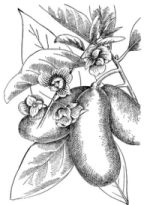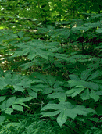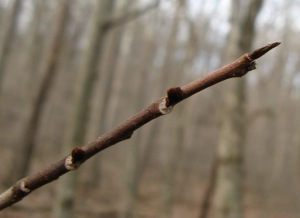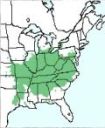Pawpaws: A Paw for You and a Paw for Me
|
Our Pawpaw, which grows as far north as New York and southern Ontario, out west as far as Nebraska and Texas, and south to Florida, is known by several other names including the American Custard Apple, the West Virginia Banana, and the Indiana Banana. There are about seven other members of the genus Asimina, all growing in the southeastern U.S. The Pawpaw made some headlines in 1992 when it was reported
that a Purdue University researcher had isolated a powerful anti-
cancer drug, as well as a safe natural pesticide from the Pawpaw
tree. The substances are said to be primarily found in the twigs
and small branches. The researcher,
Jerry McLaughlin,
revealed that it was because of some childhood experiences with eating the
fruit that he had a feeling that there was something biologically
active in the plant.
In the book, Sturtevant's Edible Plants of the World, one finds the Pawpaw fruit called "...a natural custard, too luscious for the relish of most people. The fruit is nutritious and a great resource to the savages." Millspaugh, in American Medicinal Plants, describes the fruit as "soft, sweet and insipid, having a taste somewhat between that of the May-apple and the banana, tending to the former." The Peterson Field Guide mentions that the seeds, along with being an emetic, have narcotic properties.
Closer to home, a West Virginian and DC resident, Neal Peterson, has been conducting a Pawpaw research study for the past eight years at the Western Maryland Research and Education Center near Keedysville. He has 600 trees planted on the Center's property and has been evaluating the fruit from the individual trees with an aim to choose the ten "best" trees in his orchard in order to begin producing the most tasty Pawpaws possible. Peterson hopes to bring Pawpaws to the mass market.
In January of 2009, the pawpaw was named as the native state fruit of Ohio.
State Senator Jimmy Stewart, R-20, had been trying to get the pawpaw
legislative recognition during his terms as state representative for the
92nd district from 2003-2008 after having attended his first Pawpaw
festival in Albany.
Note: October, 1997: I found a listing for Paw Paws on the NCSU Poisonous Plants of North Carolina Page. Apparently some individuals cannot eat them without severe stomach and intestinal pain. Note: September, 2005. Pawpaws should gain in popularity because deer tend not to eat them. While they will eat the fruits which have fallen to the ground, it is thought that the unpleasant smell the stem emits when it is damaged keeps the tree from being palatable to deer. In fact, in certain areas anlong the C and O Canal, botanists feel that it is becoming a weed, taking over places that used to have a wide variety of species, but where seedlings of other trees are being gobbled up by deer, leaving the pawpaws to thrive. Note: May, 2009 - I was told by someone who tends the mules and canal boats at Great Falls, MD, that unlike the deer, the mules like to eat pawpaw leaves. |
 The Autumn birding hike of October
10th was not very
productive in terms of birds. However, during the course of the
hike, several of the participants got their first introduction to the
Pawpaw, Asimina triloba. The name of this plant is sometimes
spelled Papaw - and in that form is often confused with another
fruit that sometimes goes by that name, the Papaya, Carica papaya.
(The latter is in a totally different family than our Pawpaw, and
can only grow in tropical areas.)
The Autumn birding hike of October
10th was not very
productive in terms of birds. However, during the course of the
hike, several of the participants got their first introduction to the
Pawpaw, Asimina triloba. The name of this plant is sometimes
spelled Papaw - and in that form is often confused with another
fruit that sometimes goes by that name, the Papaya, Carica papaya.
(The latter is in a totally different family than our Pawpaw, and
can only grow in tropical areas.)

 As late as the early 1900's, fishermen in the Ohio valley were
using strips of the inner bark for stringing fish. They likely learned
this use from the Indians, who used these bark strips to make fabric and
nets. It is also thought that the Indians may have been responsible for
extending the range of the Pawpaw far beyond its natural growing area.
As late as the early 1900's, fishermen in the Ohio valley were
using strips of the inner bark for stringing fish. They likely learned
this use from the Indians, who used these bark strips to make fabric and
nets. It is also thought that the Indians may have been responsible for
extending the range of the Pawpaw far beyond its natural growing area.

